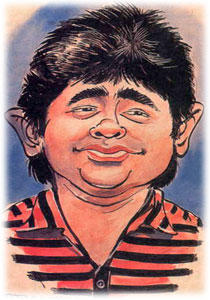Source: The Hindu
| Years of interaction with Rajmata Gayatri Devi, and the release of her biography recently, have not dimmed the starry aura for author Dharmendar Kanwar, finds ANJANA RAJAN. |

Maharani Gayatri Devi in her youth_Published in Roli Books' Family Pride series.
ONCE THERE was a schoolgirl. She adored a queen. As she grew up, the distant yet kindly and stunningly beautiful queen remained her idol. One day, they met. The little girl, now a young lady, found in the stately queen a compassionate friend, a companion in laughter, a partner in work. And they continue thus. Yet to this day, that little girl, who has grown into a prolific writer, cannot believe her amazing luck in being able to walk by the side of the queen. It's only fitting then, that she decided to record her reverence by penning Her Highness' biography.
So how do you write the story of a queen? With lots of sugar, some spice that's nice, and plenty of adulation? This formula could well apply to many of the pictorial biographies in Roli Books' Family Pride series, which features family members or close associates chronicling the lives of great people. But it is particularly the case with the latest in this series, "Rajmata Gayatri Devi... Enduring Grace" by Dharmendar Kanwar.
For Dharmendar, who has authored eight books on tourism and travel - all on her home State of Rajasthan - besides numerous articles in mainstream newspapers and magazines, this is the first biography. Associated with the erstwhile Maharani, Rajmata Gayatri Devi of Jaipur, for several years, she says, "I had already planned a book. Each meeting I had with her I had recorded. I knew enough about her life. I have also travelled with her. When the Roli Books proposal came, she felt I was the best person, and she wouldn't have to do the interviews all over again."
Writing about a strong-willed individual like the Rajmata, still active in her 80s, can be a challenge. Such a work does have to have the subject's approval, agrees Dharmendar, but, "In her case it was all right. There was nothing extraordinary that I was trying to reveal."

Dharmendar, who attended the Maharani Gayatri Devi Girls' Public School - founded by Gayatri Devi within a few years of her marriage to Maharaja Man Singh of Jaipur - recalls the Maharani's visits to the school. "She used to wear beautiful chiffon saris and pearl necklaces. It was like a fairytale for us."
It was Dharmendar's writing that brought her into direct contact with the Maharani. Still new in her career, she was sent to interview Gayatri Devi. "I remember I was very nervous and tongue-tied. I spent a sleepless night. But she spoke very nicely and put me at ease."
The awe in which even a seasoned professional like Dharmendar Kanwar holds the Rajmata is nothing unusual in the State, she points out. Even today, a glance from the Rajmata is considered a moment to prize. That she made a great contribution to women's education in Rajasthan, setting an example of emancipation and bringing women out of purdah, only adds to her exalted status as an incomparably dynamic and beautiful woman, whose pictures from her youth have the dreamlike quality of the Hollywood heroines of the 1920s and `30s.

Dharmendar Kanwar in New Delhi. Photo: Anu Pushkarna.
Dharmendar, who also works for heritage conservation, edited, designed and published a cookbook, "Gourmet's Gateway", written by the Rajmata to raise funds for charity. Not commenting much on her writing skills, she does admit to overhauling the book to make it more interesting. Not that cooking is one of the Rajmata's fortes. Points out Dharmendar, "It's written by a non-cook and published by a non-cook."
As soon as the biography was released in New Delhi, the Rajmata set off for England. But had she had been here, says her biographer, she wouldn't want to talk to the press. "Even if you talk to her, she'll tell me to write something, show it to her and send it," says Dharmendar. "I am handling all her press."
Purdah and the Rajmata don't go together, but then, royalty will have its enigmas.

